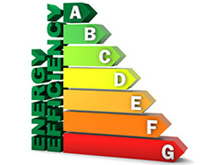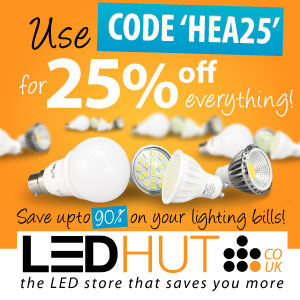LED Lights & Lighting

We all understand the benefits of reducing our electricity consumption; with spiralling electricity prices mean it is important from an affordability point of view combined with the effects of greenhouse gas emissions on climate change which can no longer be ignored.
There are many methods for reducing electricity use, no leaving things on standby, during clothes outside instead of using tumble dryers, washing clothes on lower temperatures etc, but what about lighting? We already only put lights on when it's dark so how can we reduce the amount of electricity we use for lighting without sitting in the dark? The only answer is to use more efficient lighting. There are four basic types of lighting, the traditional incandescent bulb, halogen, fluorescent and most recently LED lighting.
For 25% off everything LED lighting related at LED Hut, just click this link and place your order, on checkout enter the code - HEA25. Shop with Led Hut Ltd Now
How Do Other Types of Lighting Work?
Without getting too scientific, the traditional incandescent bulbs work by using electricity to heat a tungsten filament to very high temperatures so that it glows. Really therefore, they are mini heaters which produce light as a by product and this, together with the limited life span (because the element will inevitably burn out) is what makes them so inefficient.
Fluorescent lights pass electricity through mercury vapour causing it to glow (or fluoresce). Although more efficient than incandescent bulbs, the use of vapour to convert electricity to light causes wastage.
How Do LED Lights Work?
LED lights have been around for decades. LED stands for Light Emitting Diode. The little stand by lights on your TV or Video Recorder (or should that be Blu Ray Player??) are LEDs. They work in a similar way to fluorescent lights but with no gas which greatly reduces wasted electricity.
Although very efficient in terms of electricity consumption, the problem has always been how to harness the technology to produce a useful light source. The solution, it turns out, is to group a number of diodes together. Their combined light is then sufficient to provide light to help us see.
How Efficient is LED Lighting?
Light output from a bulb can be measured in lumens (a unit for measuring brightness) per watt (as unit of electricity), so that the more lumens per watt a light source can produce the more efficient it is and the less electricity it will use. The chart below gives an idea of the relevant efficiencies of the different lighting types:
Output (lumens/watt) Life expectancy (hours)
Incandescent 10 - 17 750 - 2500
Halogen 12 - 22 2000 - 4000
Fluorescent 30 - 110 7000 - 24000
(straight tube)
Fluorescent 50 - 70 10000
(compact)
LED (Cool 60 - 92 35000 - 50000
White)
LED (Warm 27 - 54 35000 - 50000
White)
Pros and Cons of LED Lighting
As can be seen from the table above, the “Cool White” type LED lights are the most efficient available (fluorescent straight tube lighting can sometimes be more efficient but is not really appropriate for domestic use). They are around 5 times as efficient as an incandescent bulb. To put some perspective on this, an “average UK electricity bill is around £500 per annum, of which around 20% is made up of lighting costs. If LED lighting is 5 times as efficient as incandescent then replacing all bulbs with LED lighting would reduce the annual lighting bill from £100 to around £20. In addition, a LED light will only have to be replaced something like every 15 - 20 years. In that time around 40 - 50 incandescent bulbs would need to be purchased. So the major advantages of LED lighting are cost efficiency and longevity. These are also environmental advantages of course.
LED lighting produces no UV light, which can cause health problems, contains no mercury which is damaging to the environment, lights up instantly unlike other low energy lighting and it very robust. Incandescent bulbs and fluorescent tubes are notoriously easy to break but LED lights are not. This is important considering the length of time they are intended to last.
The major downsides of LED lighting are light colour, initial cost and its “directional nature”. A 5 watt bayonet cap bulb, the type you would have in a typical ceiling light and which is equivalent in output to a 60 watt incandescent bulb, would cost around £15. Although it will also last up to 50 times longer, this initial outlay can be off putting.
For 25% off everything LED lighting related at LED Hut, just click this link and place your order, on checkout enter the code - HEA25. Shop with Led Hut Ltd Now
The light from an LED bulb tends to have a bluish tinge, unlike to the yellow light that we are more used to. It can appear cold and clinical, though it is more closely matched to daylight and in that sense could have a positive effect on mood. It is possible to produce the more usual yellow tinged light with a “warm white” LED bulb but as can be seen from the table above. These are perhaps only half as efficient as their “cold white” counterparts.
Unlike incandescent light, which is quite diffuse, LED light is very directional. This means the light from an LED bulb will be focused on a particular area rather than being spread through the room. Whilst this is useful for task lighting, spot lights and reading lamps for example, it is not so good if you want to light a whole room with a single bulb. The problem can be overcome with additional light fittings or with a cluster of bulbs pointing in different directions.
Cost of LED Lighting
A 5 watt LED bulb, with equivalent output of a 60 watt incandescent bulb (a typical ceiling light/lamp bulb) will cost around £15, so to replace all of the bulbs in a typical home which will have around 12 bulbs would cost £180. Although this seems awful lot to spend on light bulbs, if you remember that during the lifespan of an LED bulb you would need to buy up to 50 incandescent bulbs, so unless you could get each one for 30p or less, LED bulbs will eventually work out cheaper, even without the efficiency savings.
With efficiency savings of around £80 per year however LED lighting will in fact pay for itself in just over two years and will continue to shine for many more years to come.
For 25% off everything LED lighting related at LED Hut, just click this link and place your order, on checkout enter the code - HEA25. Shop with Led Hut Ltd Now


 config
config view
view logs
logs 2048.0 KB
2048.0 KB



